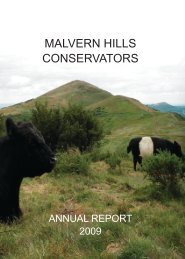Footpath degradation of the Malvern Hills - Malvern Hills Conservators
Footpath degradation of the Malvern Hills - Malvern Hills Conservators
Footpath degradation of the Malvern Hills - Malvern Hills Conservators
You also want an ePaper? Increase the reach of your titles
YUMPU automatically turns print PDFs into web optimized ePapers that Google loves.
Stephen Britnell<br />
<strong>Footpath</strong> <strong>degradation</strong> <strong>of</strong> <strong>the</strong> <strong>Malvern</strong> <strong>Hills</strong><br />
Overland flow occurs during a rainstorm when surface depression storage, soil<br />
moisture storage, and <strong>the</strong> infiltration capacity <strong>of</strong> <strong>the</strong> soil are exceeded. During peak discharge<br />
overland flow covers up to two thirds <strong>of</strong> a hillside, and is rarely as sheet <strong>of</strong> water with uniform<br />
depth, but as <strong>of</strong> braided watercourses (Horton 1945). At <strong>the</strong> top <strong>of</strong> <strong>the</strong> slope <strong>the</strong>re is a zone<br />
without flow due to high infiltration, this forms a belt <strong>of</strong> no erosion. At a critical distance from<br />
<strong>the</strong> crest enough water accumulates for flow to begin (Horton 1945). Flow is broken up by<br />
stones and cobbles, and by vegetation cover, <strong>of</strong>ten swirling around tufts <strong>of</strong> grass and small<br />
shrubs as turbulent flow focusing erosion in <strong>the</strong>se areas. At a fur<strong>the</strong>r critical distance, <strong>the</strong> flow<br />
becomes concentrated into fewer deeper flow paths, which occupy a progressively smaller<br />
proportion <strong>of</strong> <strong>the</strong> hillside. (Parsons et al. 1990)<br />
The result <strong>of</strong> <strong>the</strong> channelled flow is rill formation. Rills are small channels formed by<br />
converging flows that scour out a trench. The change from overland flow to rills occurs in four<br />
stages. Firstly from a non-concentrated channel flow, to overland flow with concentrated flow<br />
paths, next as micro channels without headcuts, and finally as micro channels with headcuts.<br />
The greatest differences in flow exist between <strong>the</strong> first and second stages (Merritt 1984). In<br />
<strong>the</strong> second stage, small vortices appear in <strong>the</strong> flow. In <strong>the</strong> third stage <strong>the</strong>y develop into<br />
localised spots <strong>of</strong> turbulent flow, characterised by roll waves and eddies (Rauws 1987). At <strong>the</strong><br />
point <strong>of</strong> rill initiation, <strong>the</strong> flow conditions change from subcritical to supercritical. At this time<br />
knick points or headcuts may form.<br />
Subsurface flow or interflow is characterised by <strong>the</strong> lateral movement <strong>of</strong> water<br />
downslope through <strong>the</strong> soil in tunnels and subsurface pipes. The result <strong>of</strong> concentrated flow in<br />
tunnels and subsurface pipes is tunnel collapse and gully formation (Morgan 1995). Gullies<br />
are relatively permanent steep sided watercourses. They are characterised by a headcut and<br />
various knick points along <strong>the</strong>ir course. Gullies are associated with accelerated erosion and<br />
<strong>the</strong>refore with landscape instability (Morgan 1995).<br />
15





